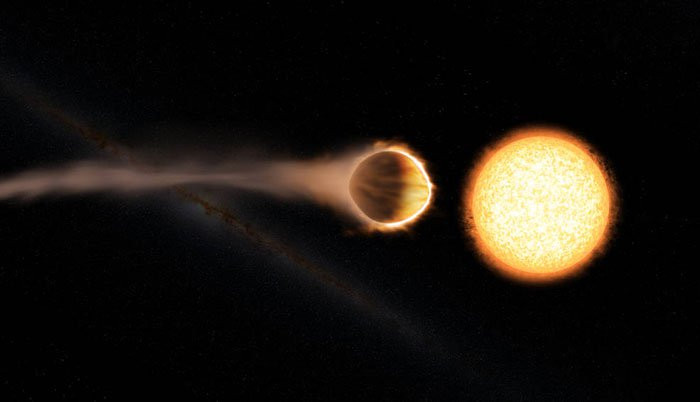WASP-121b, a planet 900 light years from Earth, has an atmospheric temperature of 2,500 ° C, so hot it can even melt iron.
The international team led by the National Competence Center for Planetary Research at the University of Bern and the University of Geneva (Switzerland) “entered” the atmosphere of WASP-121b, a super exoplanet. hot.
This planet orbits its parent star 40 times closer than the Sun-Earth distance, so it has received a tremendous amount of heat.
According to Dr. Jens Hoeijmakers, one of the lead authors of the study, they checked the data with the HARPS spectrophotometer and identified at least 7 metals that exist in the gaseous body of this planet: iron, chromium, calcium, sodium, magnesium, nickel.
Before that, in 2019, when it was first discovered, this strange planet caught the attention of scientists because it was not a round sphere but … oval in shape. The reason is that it spins too close to the mother star and is pulled strongly by the star’s gravity, distorting the sphere. Perhaps in the future he will soon be destroyed in this disproportionate struggle.
The “hell” planet WASP-121b, discovered four years ago in the constellation Korma, turns out not to have the shape of a round ball, but rather an oblong egg or a giant oval ball. giant.
“We began to observe the planet due to its ‘extreme’ nature. We tried to see traces of magnesium, iron and other metals in the outer shell and were very surprised to find them. very far from the planet, ”said expert David Singh from Johns Hopkins University in Baltimore (USA).
 Due to its proximity, the upper part of the planet’s atmosphere has a temperature of up to 2500 ° C.
Due to its proximity, the upper part of the planet’s atmosphere has a temperature of up to 2500 ° C.
WASP-121b is a gas giant nearly twice the size of Jupiter and revolves around the mother star. This exoplanet is so close to its parent star that one year there will be only 1.3 days on Earth. Due to its proximity, the top of the planet’s atmosphere reaches 2,500 ° C, which is about half the surface temperature of the Sun. At this temperature, iron exists as a gas rather than a solid.
WASP-121 violently pierced the atmosphere of its satellites, causing it to be “inflated” by the influence of heat and light, and also affected by its gravity. As a result, WASP-121b not only becomes the hottest and most extreme planet, but also a bizarre looking planet.
“When we pointed the Hubble Space Telescope at the WASP, we saw glowing water molecules, showing that the planet has a thick stratosphere,” says Tom Evans, a researcher at the University of Exeter, UK . said. Hubble glasses see this light as infrared light that cannot be seen by the human eye.
“Theoretical models indicate that the stratosphere could help identify a particular superheated exoplanet layer, which is important for physical and chemical research in the atmosphere,” Evans said.
By examining the wavelength of light entering space from gas on the planet, researchers can calculate the amount of water vapor in the atmosphere and its heat. Cooler water in the upper layer of the atmosphere can prevent transmission of certain infrared wavelengths, according to the United States Aerospace Agency (NASA). But the hotter vapor will emit the same wavelength. From the amount of light released into space, the team noticed that the temperature increased with altitude.
“This super hot exoplanet will become a milestone for our atmospheric model. It will be a major observing target during the days of the James Webb Space Telescope,” said central scientist Hannah Wakeford. NASA’s Goddard Space Center, co-author of the study, shared.


